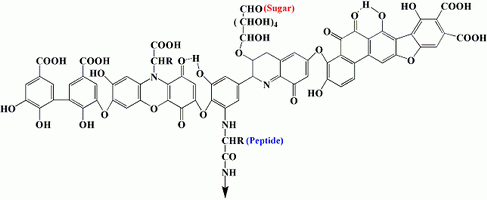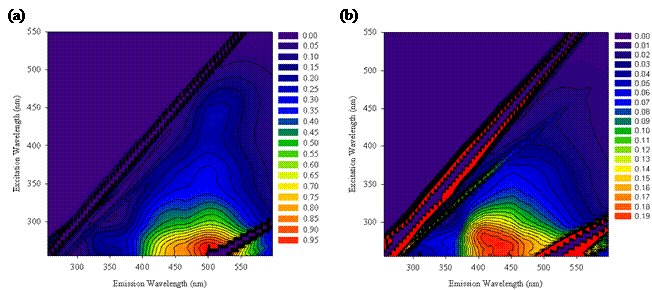|
Prof. Hadi M. Marwani
Professor of Analytical and
Environmental Chemistry
King Abdulaziz University
Faculty of Science
Chemistry Department
P.O. Box: 80203 Jeddah, Saudi Arabia 21589
Email: hmarwani@kau.edu.sa
Phone: +966-2-6952293
Fax: +966-2-6952292
|
|
Our research interest involves the development of new instrumental methods and materials for analytical measurements. The primary focus is to provide improved methodology for:
- Multi-component systems to explore their potential applications
- Selective separation of organic and inorganic pollutants present in complex matrices
- Determination of trace and ultra-trace concentrations of organic and inorganic pollutants present in various matrices
- Ionic liquid compounds and their recent applications
|
Humic Materials and Their Characterization
Humic Materials (HM) are heterogeneous polydisperse mixtures and constitute a series of relatively high molecular weight aggregates, yellow to black organic compounds of aliphatic and aromatic nature (Figure 1). HM are found in soils, natural waters, sewage, marine and lake sediments, compost heaps, peat bogs, lignites, brown coals, and miscellaneous other deposits. Their abundance in soils is two to three times higher as compared to the living mass of organic matter. HM are operationally classified based on aqueous solubility into three major fractions: humic acids (HA), fulvic acids (FA), and humins. HA are soluble in alkaline media but participate at pH 2. FA are soluble in water at any pH value, and humins are insoluble in water under any condition.

Figure 1. Proposed molecular structure for soil HA by Stevenson (Stevenson, F. J. Humus Chemistry: Genesis, Composition, Reactions, Second ed.; John Wiley & Sons: New York, 1994)
Characterization of HM from both terrestrial and aquatic components of the ecosystem can be achieved by use of high resolution techniques to provide details about their elemental and functional groups composition and molecular structure. Characterization techniques of HM involve nuclear magnetic resonance (NMR) spectroscopy, Fourier transform infrared (FT-IR) spectroscopy, and fluorescence spectroscopy. For example, fluorescence properties of the fluorophore can be studied by use of three-dimensional excitation–emission matrices (EEM) fluorescence, which can simultaneously measure different fluorescence properties in single measurements and minimize the analysis time (Figure 2).

Figure 2. EEM spectra of the (a) peat derived Amherst humic acid (AHA) and (b) chemically bleached Amherst humic acid (BAHA) normalized at the maximum fluorescence of AHA EEM spectra
|
|
The Association between Organic Chemicals and Humic Materials
Soils and waters are hosts to large quantities of organic chemicals, which are presented either intentionally or accidentally in our environment. Organic pollutants may interact with soils and waters via many sources, such as municipal and industrial wastes and landfill effluent. When these chemicals reach soil surfaces, their degradation will be subject to several fates. They may be sorbed by the soil or transport to the aquatic environment through run-off into surface waters. These organic chemicals are aliphatic and aromatic derivatives of petrol and plastics, such as polycyclic aromatic hydrocarbons (PAHs) and pesticides and their biological, chemical, and photochemical degradation products. The association of hydrophobic organic compounds (HOC) with HM present in soils and waters has continued to be one of the interesting areas in analytical and environmental applications because of the high affinity of HOC to HM and the potential risks to the environment. The interaction of HOC with HM can result in an increase of the contaminants mobility and a decrease in their toxicity and bioavailability. Therefore, our major interest is focused on the development and application of a series of analytical methods, such as NMR, high performance liquid chromatography (HPLC), and fluorescence spectroscopy, to gain a deeper mechanistic understanding of how HM are transported in the environment and involved in the fate of HOC, such as PAHs and chiral pesticides. For example, a new approach to frequency-domain fluorescence lifetime measurements, based on frequency segmentation and recombination, was previously developed to carefully investigate the association mechanism between HOC and HM, Figure 3.

Figure 3. Experimental frequency-domain long run (LR) and combined run (CR) data and non-linear least squares (NLLS) fits for pyrene (0.04 ppm) and Suwannee River fulvic acid reference (12 ppm) mixture. Solid and open symbols represent phase and modulation, respectively
|
Selected Publications
Marwani, Hadi M.; Lowry, Mark; Keating, Patrick; Warner, Isiah M.; Cook, Robert L. Segmented Frequency-Domain Fluorescence Lifetime Measurements: Minimizing the Effects of Photobleaching within a Multi-component System. J Fluoresc 2007, 17, 687–699.
Bwambok, David K.; Marwani, Hadi M.; Fernand, Vivian E.; Fakayode, Sayo O.; Lowry, Mark; Negulescu, Ioan; Strongin, Robert; Warner, Isiah M. Synthesis and Characterization of Novel Chiral Ionic Liquids and Investigation of their Enantiomeric Recognition Properties. Chirality 2008, 20, 151–158.
Richard, Gerald I.; Marwani, Hadi M.; Jiang, Shan; Fakayode, Sayo O.; Lowry, Mark; Strongin, Robert M.; Warner, Isiah M. Chiral Recognition of Amino Acids by Use of a Fluorescent Resorcinarene. Appl. Spectrosc. 2008, 62, 476–480.
Marwani, Hadi M.; Lowry, Mark; Xing, Baoshan; Warner, Isiah M.; Cook, Robert L. Frequency-domain Fluorescence Lifetime Measurements via Frequency Segmentation and Recombination as Applied to Pyrene with Dissolved Humic Materials. J. Fluoresc. 2009, 19, 41–51.
Selected Awards and Honors
National Affiliate of the American Chemical Society (2004-present).
Bachelor of Science Degree in Chemistry with First Class Honors, Upper Division (King Abdulaziz University, 1998).
Winner of Chemistry Departmental Research Scholar for Outstanding Research Achievement (Louisiana State University, 2007).
Certificate of Acknowledgement for Outstanding Academic Accomplishment, Research and Consulting Institute, King Abdulaziz University, Jeddah, Saudi Arabia (2008).